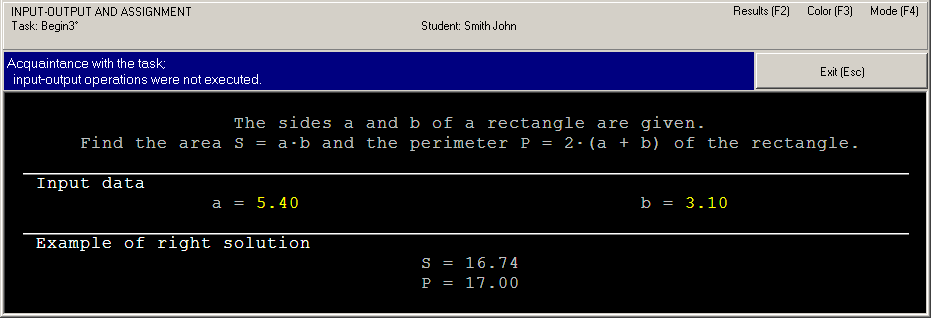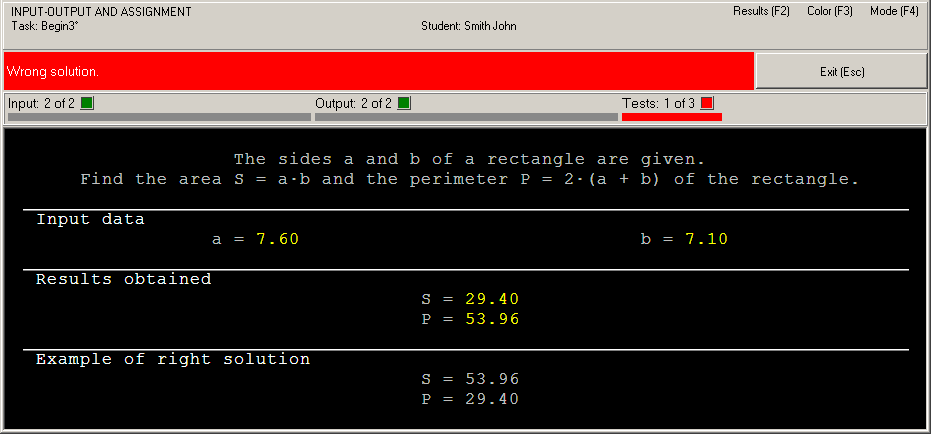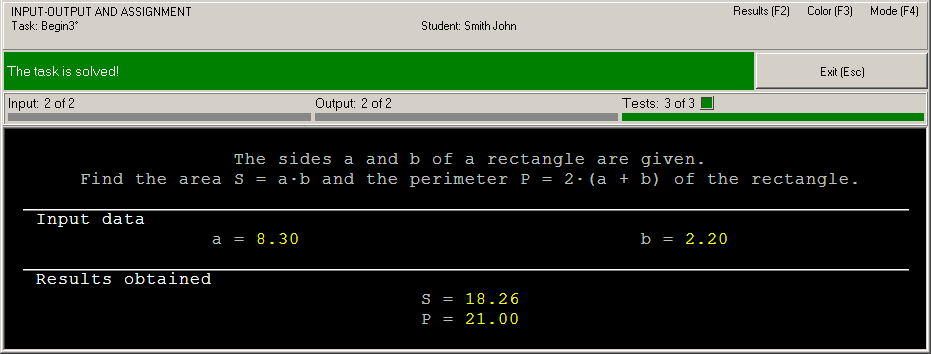|
Programming Taskbook |
|
|
||
|
Electronic problem book on programming |
||||
|
© M. E. Abramyan (Southern Federal University, Shenzhen MSU-BIT University), 1998–2026 |
|
|
Solution of the simple task: Begin3This section contains description of solving the following simple task in Java. Begin3°. The sides a and b of a rectangle are given. Find the area S = ab and the perimeter P = 2(a + b) of the rectangle. We shall use the VS Code as programming environment, however the same results may be received in the Eclipse IDE. Creating a template and acquaintance with the taskTo create a template of the required task you should use the PT4Load tool (starting with version 4.22, you can use the PT4Panel tool for quick launch of all Programming Taskbook tools; the PT4Panel shortcut is located on the desktop and in any working directory). The created template is located in the PT_Java subdirectory of the working directory and consists of several files and subdirectories. But we need only MyTask.java file located in the src subdirectory. This file will be loaded into the code editor of VS Code IDE: // File: "Begin3"
public class MyTask extends PT
{
public static void solve() throws Exception
{
task("Begin3");
}
}
The final part of the file contains a description of the main function, which should not be changed. The MyTask.java file contains definition of the MyTask class; this class is a descendant of the PT class defined in the PT.java file. The MyTask class includes the solve function as its method. The solve function already contains the task function call that initializes the Begin3 task. The solution of the task should be entered in the solve method (of course any other methods may be used). Note that the task function (just as get-functions and the put function) is a class method of the PT class (all these methods are declared with the "static" attribute). All these methods are called in the solve method of the MyTask class (that is a descendant of the PT class), therefore it is not necessary to qualify these methods with the PT prefix. To run the program, press [F5] in VS Code and [F11] in Eclipse. When the program is launched you will see the Programming Task window with a task text and initial data.
This running is considered as acquaintance running because the program does not perform input-output operations. To close the Programming Taskbook window, click the Exit button or press [Esc] (or [F5] in VS Code and [F11] in Eclipse). Initial data inputBefore solving tasks you should input initial data in the program. In the Begin3 task the initial data are real numbers a and b that refer to sides of the rectangle. The initial data should be input in the variable of the required type, otherwise Programming Taskbook will detect error. Let's model this situation in our program. For this purpose, we shall organize initial data input to variables of the integer type using the getInt function: public static void solve() throws Exception
{
task("Begin3");
int a = getInt(), b = getInt();
}
Run the program once again. You will see the new set of initial data. For each running of the program a new initial data are generated, so it is necessary to develop an algorithm that processes correctly all admissible sets of initial data.
In this case the running leads to the following information in the status bar: "Invalid type is used for an input data item." Note that each type of errors is marked by different color. To input data correctly we should use the getDouble function that provides input data of double type. Change our program as follows: public static void solve() throws Exception
{
task("Begin3");
double a = getDouble(), b = getDouble();
}
Now data input is performed correctly, but the program does not output results. In such situation we have the following message: "Correct data input: all required data are input, no data are output" (Programming Taskbook version 4.15 or higher) or "Some data are not output" (previous versions). Calculation and output resultsLet's perform the required calculations and output results using the put function: public static void solve() throws Exception
{
task("Begin3");
double a = getDouble(), b = getDouble(), S, P;
S = a * b;
P = 2 * (a + b);
put(P, S);
}
When the program is running you can see output values at the panel of results. Because we output data in inverse order, the status bar contains the error message "Wrong solution".
Correct solution and testingTo correct the last error it is enough to change order of arguments in the put method call: put(S, P); When this program is running you will see the testing panel on screen:
This panel appears when the program processes successfully at least one set of input data. The progress bar shows the amount of tests which are already performed, the text above the bar allows to determine how much tests should be performed successfully. The program testing finishes in two cases: when all required tests are performed successfully or when some test is failed. In our case, the algorithm is correct, therefore the message "The task is solved!" will be shown.
To browse information about the task solving, you can use PT4Results tool (you may run this tool by pressing the [F2] key or clicking the Results label in the upper-right corner of the Programming Taskbook window): Begin3 j23/02 20:13 Acquaintance with the task. Begin3 j04/02 15:07 Invalid type is used for an input data item. Begin3 j04/02 15:09 Correct data input. Begin3 j04/02 15:12 Wrong solution. Begin3 j04/02 15:15 The task is solved! The letter "j" denotes the programming language being used (Java). Remark. It is not necessary to use additional variables S and P, because you can output expressions: public static void solve() throws Exception
{
task("Begin3");
double a = getDouble(), b = getDouble();
put(a * b, 2 * (a + b));
}
|
|
|
Designed by |
Last revised: |







